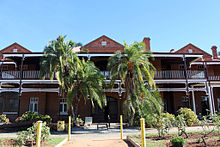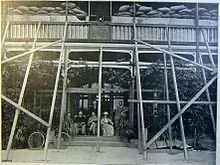- McGregor Museum
-
The McGregor Museum in Kimberley, South Africa, originally known as the Alexander McGregor Memorial Museum, is a province-aided museum established in 1907.
Contents
Overview
Housed at first in a purpose-built museum building in Chapel Street, Kimberley, the museum was, and still is, governed by a Board of Trustees, aided financially by the municipality (up to the 1950s), then by the Cape Provincial Administration and, today, by the Northern Cape Administration through the Department of Sport, Arts and Culture.
Alexander McGregor had been a Mayor of Kimberley, whose wife bequeathed the building to perpetuate his memory.[1]
Today the museum has its headquarters at the old Kimberley Sanatorium building in Belgravia, Kimberley, and it has several satellites including the original building in Chapel Street.[2] The museum opened its doors on 24 September 1907. By coincidence 24 September was chosen as Heritage Day, a public holiday in South Africa post-1994.
The McGregor Museum is a primary research institute in and for the Northern Cape (a province with a National Institute for Higher Education, but still lacking a university) in fields of natural and cultural history (including zoology, botany, general history, South African struggle history, archaeology, social anthropology). It curates important collections and archival material (see below) and, on the basis of its collections and research activities, performs educational and outreach functions to the community locally and throughout the province. Research programmes include international collaborative projects.
Museum directors
The McGregor Museum operates under a Board of Trustees, originally aided by the Kimberley Municipality, De Beers and many donors (from 1907), then aided by the Cape Provincial Administration (from 1958) and as a Province-aided Museum receiving an annual grant from the Department of Sport, Arts and Culture, Northern Cape Province, which also employs the staff of the museum (post-1994).
Directors of the McGregor Museum have been:
- Maria Wilman (1908–1946)
- John Hyacinth Power (1947–1958)
- Rudolph Carl Bigalke (1958–1964)
- Richard Liversidge (1966–1986)
- Elizabeth Anne Voigt (1987–1999)
The current Museum Director is Colin Fortune (from 2000).
Collections and exhibits
The museum houses major natural history and cultural history collections including a botanical herbarium, zoology collections, a history archive (including documents, photographs and oral history recordings), ethnography collections, archaeology and rock art collections, physical anthropology, palaeontology and geology collections. Most of these fields are represented by professional staff and collection managers, and the collections and associated research programmes are reflected in permanent and temporary exhibits in various sections and buildings of the museum as well as in outreach programmes in the province and displays in smaller museums.
Expansion to the sanatorium
Outgrowing available space at its buildings in town,the museum's headquarters were moved in 1973 to the former Kimberley Sanatorium (built in 1897), which at one time served also as the Hotel Belgrave (1902–1933) and as the Holy Cross Convent School, Kimberley (1933–1971). The new museum headquarters were officially opened on 22 November 1976. For the duration of the Siege of Kimberley (14 October 1899 – 15 February 1900) during the Anglo-Boer War, Cecil John Rhodes lodged in rooms at what was then the Sanatorium.
Satellites
Branches of the McGregor Museum today include the original McGregor Memorial Museum in town (city history displays), the Duggan-Cronin Gallery (photographic and ethnographic museum), two house museums, Dunluce and Rudd House, the Pioneers of Aviation Museum, the Magersfontein Battlefield Museum, Wonderwerk Cave near Kuruman and the Wildebeest Kuil Rock Art Centre outside Kimberley.
Some major museum projects and programmes
- Founding of the South African Museums Association in Kimberley in 1936
- Building of Chapwood Building with funds from McGregor Family, 1950s
- The Griqualand West Story, 1959
- Rudd House donated to the museum, 1969
- Magersfontein Battlefield Museum development, 1971 (refurbished in 1999 for the Anglo-Boer War centenary)
- Move to the Sanatorium and building of new displays, 1973-1976
- Dunluce donated to the museum, 1975
- Memorial to the Pioneers of Aviation Museum, 1981
- Nooitgedacht open air displays, 1985
- Restoration and opening of Rudd House, 1988 (restored again in 2008)
- Opening of the new Humanities Block, 1991
- Wonderwerk Cave Site Museum opening, 1993
- Displays on the coming of democracy opened by Premier Manne Dipico, 1995
- Through Vuzi's Lens - photographic display
- Sol Plaatje Museum displays at 32 Angel Street
- Frontiers Gallery opened by Khuza Bogacwi, 1998
- Ancestors Gallery opened by MEC Brian Hermanus, 1999
- Victoria West Museum displays opened
- Magersfontein Battlefield Museum refurbished for the centenary, 1999
- Siege of Kimberley Concert and Ball, 1999, 2000
- Canteen Kopje and Barkly West Museum, 2000
- Wildebeest Kuil Rock Art Centre public archaeology development, 2001, opened by Premier Manne Dipico and Cheryl Carolus
- Robben Island project exhibition, opened by Ahmed Kathrada, 2001
- Workshop on human remains and publication of Skeletons in the Cupboard, 2001
- Malay Camp[3] and Greenpoint history projects, 2002
- Finalist in first Provincial Premier's Award, 2003
- Ten Years of Democracy displays, 2004, and a contribution to the "Democracy X" exhibition at Iziko South African Museumin Cape Town, in the same year.
- Duggan-Cronin photographic exhibitionat Museum Africa in Johannesburg
- Malay Camp displays opened by Premier Dipuo Peters, 2006
- Duggan-Cronin Gallery restoration and new displays, 2007
- Thandabantu exhibition, Alfred Martin Duggan-Cronin and Richard Madela - a photographic journey through Southern Africa 1919-1939, at Iziko South African Museum, Cape Town, 2007
- McGregor Museum Centenary,1907-2007 - restoration of the original museum building with new displays
- Wildebeest Kuil Rock Art Centre declared a Provincial Heritage Site, 19 Sep 2008.[4]
- Rudd House restored and re-opened, 23 Sep 2008.
- Contributed Stow's copies of rock engravings to the "George William Stow Exhibition" at Iziko South African Museum, Cape Town, November 2008.
- Wonderwerk Cave approved as a Grade 1 National Heritage Site, Mar 2009. An international symposium on the site was held at Wonderwerk Cave in June 2009.[5]
- A role in the government project entitled ‘The History of the Liberation Struggle in the Northern Cape’ (2009). “This project will encapsulate our role as a province in the liberation struggle, and will serve as a gift from our veterans to the youth of the province,” said Premier Hazel Jenkins in her State of the Province Address, 12 June 2009. [6] The project was launched at the McGregor Museum on Heritage Day 24 September 2009.
- The "Sacred Legacy" exhibition combining the "Shared Legacies", namely the photographic works of Edward Curtis and Alfred Martin Duggan-Cronin, opened at the Centre for African Studies, University of Cape Town, 14 October 2009.[7]
References
- ^ Hart, R. (ed) 2007. Chapters from the past: 100 years of the McGregor Museum, 1907–2007. Kimberley: McGregor Museum.
- ^ Hart, R. (ed) 2007. Chapters from the past: 100 years of the McGregor Museum, 1907–2007. Kimberley: McGregor Museum.
- ^ Allen, V. 2006. Malay Camp: a forgotten suburb. Kimberley: McGregor Museum & Depts Sport, Arts & Culture and Tourism, Environment & Conservation
- ^ State of the Province Address by Northern Cape Premier Hazel Jenkins, 12 June 2009
- ^ Bamford, M. & Thackeray, F. 2009. Continued excavations at Wonderwerk Cave. The Digging Stick 26(2):21-22
- ^ State of the Province Address by Northern Cape Premier Hazel Jenkins, 12 June 2009
- ^ Documenting Indigenous Peoples
External links
Categories:- Buildings and structures completed in 1897
- Museums established in 1907
- Museums in South Africa
- History museums in South Africa
- Natural history museums in South Africa
- Archaeology museums in South Africa
- Museums in the Northern Cape
- Northern Cape
- Biographical museums
- Kimberley, Northern Cape
- Buildings and structures in Kimberley, Northern Cape
- Karoo
Wikimedia Foundation. 2010.


